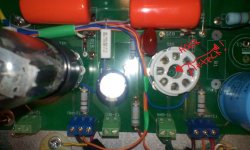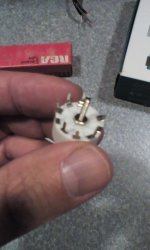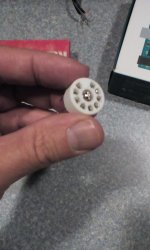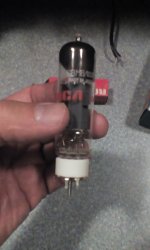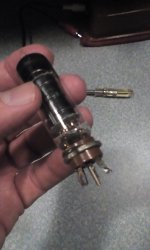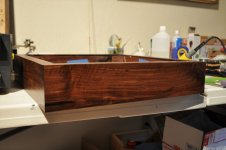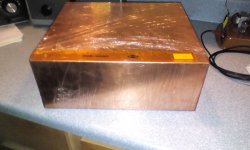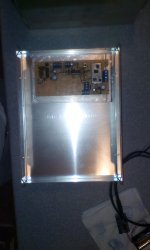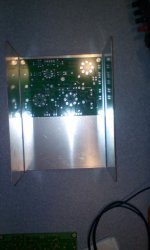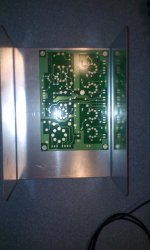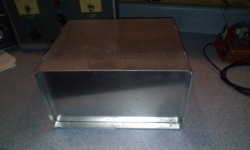If I find them I have a bunch of cheap tubes to try that will require some W5JAG style board hacking. I'm thinking an aluminum L bracket for the odd tube sockets rather than a hole in the board though.
LOL. Hmmm, I wonder if one could deftly punch a hole large enough for a seven pin socket, but still small enough to leave the nine pin traces intact?
I can't help but notice some tube sockets have a small hole through them, dead center. Presumably for the cheesy LED light ( which I kind of like, actually ). I'm thinking of drilling a small hole through the center of the pcb socket pad, then rigging some kind of a post to stick up vertically, may be as simple as screws and nuts, then mount the new socket on the vertical post.
Connect the wires from the new socket to the appropriate point on the pcb.
Might work. Been meaning to try this on an SSE, and if you look close at some of the pictures of my child resistant SSE, you can see the pilot holes drilled in the pcb under the power tube keyslot, to try this out. Thought I might try nine pin tubes in the SSE. Just haven't got around to it yet, got distracted by four and five pins .......
Win W5JAG
Attachments
some tube sockets have a small hole through them, dead center
Some tubes have the evacuation stem in the center of the base instead of on the top of the tube. I have only seen this on compactrons, but it is in the outline spec for 7 and 9 pin miniature tubes, so the sockets should accommodate it. Many old tube sockets had a metal insert in the center hole that was usually connected to chassis ground, and often used as a tie point for bypass caps on RF and IF amps that were wired point to point.
There were a very few 10 pin tubes with a pin in the center. Again, I have never seen one, but I ran across a data sheet somewhere.
Presumably for the cheesy LED light
I have a little P-P guitar amp that coincidentally uses a 70 volt line transformer for an OPT. I wired a pair of orange LED's in series with the screen supply resistor of the output tubes. It makes the tubes glow orange when you crank it even though the amp doesn't run the tubes hard enough to do that. The whole amp has about $40 worth of parts in it and the power supply can't melt the $1 tubes.
I was going to do the tube sockets on a post thing with one of Pete Millett's big red board, but I wound up using short pieces of bus wire from some of the pins on the octal socket to pins on the 12 pin socket on the PC board. This was enough to hold the octal socket onto the board.
Now....back to mowing the yard.
What tubes and OPT's are you going to use?
whoops: I see you are going with big Hammond's. Looking forward to see your outcome!
Win W5JAG
Opinions on transformer choice please. Edcors are 1/2 the price.
Opinions on transformer choice please. Edcors are 1/2 the price.
I'm not an audiophile, and have very little experience with OPT's, so I'm afraid you are asking the wrong person.
That said, from when I was looking at distributed load doing the DHT SSE, I seem to recall that 6BQ5's are optimum at a different % impedance from all other power tubes.
Going from memory, it seems the number was 20 or 21% distributed load. Note that in most of the old papers, they specify distributed load as per cent impedance, which is not the same thing as per cent of turns, so some arithmetic is required. Edcor specifies 40%, which I assume is per cent of turns, which would be 16% impedance, if I recall my arithmetic.
I believe OPT's based on the Dynaco specification for their ST-35 amp, have the correct distributed load impedance for 6BQ5. Reproductions of that are available.
None of that may be relevant to how you want to use your SPP.
The 6BQ5 looks to be a really unique tube.
Win W5JAG
....I was going to do the tube sockets on a post thing with one of Pete Millett's big red board ....
Looks like with the right hardware, it could work. This was just a trial fit with some 2-56 hardware I had on hand, not necessarily optimum for the task.
The 6BM8 is sitting in a modern Chinese socket. The 6AQ5 is an old U.S. seven pin socket. Both tubes seat fully in the socket, without obstruction from the center "post".
Win W5JAG
Attachments
Opinions on transformer choice please.
I have used Edcor's best (the CXPP100 - 3.3K, excellent) and their cheapest (XPP10-10K, not impressed). I have no experience with anything in the middle.
I have also used some of the cheaper Hammonds, and a few of the mid priced versions, but most of that was done over 10 years ago, and with guitar amps, so the info is not relevant. The big Hammond SE transformers have a resonant notch that falls real close to the audio band causing HF roll off unless you apply a ton of feedback. Never tried their big P-P OPT's.
If I had to buy a set of new OPT's for an SPP today I would use an Edcor, probably a CXPP25-8K or bigger if the budget was available. I am still burning through a stash of surplus guitar amp OPT's that work quite well as HiFi OPT's if wired for 3300 ohms. The SPP can do that with 6CW5's or when both channels are paralleled (PPP) with 6BQ5 / EL84 for about 50 watts.
The 6AQ5 is an old U.S. seven pin socket
I still have several hundred crusty old 6AQ5's that were pulled from military spares. I had about 1000 of them but most were so corroded that the pins would break off in the socket. I had fun frying them with a clip lead test fixture. I even tried wiring a dozen in parallel push pull, but that was a disaster with old mismatched tubes. I did learn one thing about the 6AQ5, there is a very slim margin between red plate and hole in the glass! Even a dull red glow will soften the glass and the vacuum will suck the side in causing a craterized runaway.
Again, this depends on your speakers and how much bass you listen to. The ability of an OPT to pass large amounts of deep bass is largely dependent on the size of the core. I am not joking when I say one of the most important specs in an OPT is the weight.
I have not tried any of these Edcors myself except for the 100 watt version which IS overkill for an SPP. Too much iron tends to reduce the OPT's ability to pass fine details.
The OPT's that I use on my SPP's are about the same size as the 25 watt Edcor (roughly 5 pounds), so the 25 watt version is probably a good choice for most applications. I had not actually looked up the weight of the 25 watt OPT when I made that comment. My 5 pound OPT's are rated for "80 watts" in guitar amp duty (lowest note is around 80 Hz). They will hit around 40 Hz on an SPP before saturation sets in. They are seriously low budget transformers made by the Schumaker battery charger company. The Edcor CXPP's are specified from 20 Hz to 20 KHz, but I don't know how well they actually do.
I'm not sure if the 50 watt version would be better, unless you have speakers capable of responding to bass in the 20 to 60 Hz range and play music that has significant energy in that range.
I have not tried any of these Edcors myself except for the 100 watt version which IS overkill for an SPP. Too much iron tends to reduce the OPT's ability to pass fine details.
The OPT's that I use on my SPP's are about the same size as the 25 watt Edcor (roughly 5 pounds), so the 25 watt version is probably a good choice for most applications. I had not actually looked up the weight of the 25 watt OPT when I made that comment. My 5 pound OPT's are rated for "80 watts" in guitar amp duty (lowest note is around 80 Hz). They will hit around 40 Hz on an SPP before saturation sets in. They are seriously low budget transformers made by the Schumaker battery charger company. The Edcor CXPP's are specified from 20 Hz to 20 KHz, but I don't know how well they actually do.
I'm not sure if the 50 watt version would be better, unless you have speakers capable of responding to bass in the 20 to 60 Hz range and play music that has significant energy in that range.
Woofers I'm using now go as low as 46Hz. Using active crossovers the bass is turned up just enough to hear it, not much more. Our music runs just about everywhere. We like mid's 7 high's more that bass. The 25 watters should bo it.
Something else. Do I nee 23% screen tap for ultra linear mode? What does that get me!
Something else. Do I nee 23% screen tap for ultra linear mode? What does that get me!
Last edited:
... including a 1 Kilowatt tube amp. I already have the necessary parts for these projects ....
I guess this is another one of those deals that takes a while to sink in .....
How are you planning on doing it? Tetrodes? Couple of 4CX1500's? They have a lot tougher screen grid than the 4CX1000. I'm guessing they could be driven with a receiving pentode like a 6AK6 .....
I once had aspirations of building a compact kw out of a pair of 4CX250B's, but then lost interest and sold/gave away all of my 4CX250 stuff. I ran across a couple more sockets a while back, and still have the case I intended to use. I think I may still have a PT in the warehouse of junk. Yes, that is real copper sheet metal .....
I don't have any RF tubes bigger than 572B's, except for some 4-400 pulls, that may or may not be any good ......
I'm thinking low power for my SPP build. I want to make a complete FM receiver, and I have this LMB Heeger cabinet in stock. The bottom chassis has plenty of room for the solid state stuff, most of which still needs to be built, but top side will be tight. An SSE board will just fit transversely, but the little bit of extra width on the SPP makes it longitudinal only. I've had this in the back of my mind for a while, which is why 6G6 went immediately into the push pull test mule with the psuedo SPP front end. I'm thinking 6AK6 for the power tubes - should be able to get 2-3 watts without a lot of heat to dissipate.
Getting a power supply into the cabinet, OPT's, etc., and dealing with the generated heat will be challenging. I have some ideas, unconventional, don't know if they will work. I want to use a one box solution - no external power supply, if possible.
Win W5JAG
Attachments
How are you planning on doing it? Tetrodes?
I abandoned, and sold most of my big RF tubes years ago. The reality is that an OPT capable of the voltages and impedances that big RF tubes want, are out of my price range. I still have a few 833A's, a plate transformer out of a Harris transmitter, and an SE OPT suitable for a guitar amp (but only one) so I may build a big guitar amp some day.
I lucked into some "surplus" Plitron P-P OPT's several years ago that are 1250 ohms, 400 watts at 20 Hz and suitable for a high quality HiFi amp. The usual suspects for these OPT's are 6 to 8 KT88's, but I will use TV sweep tubes, probably 36LW6's or 35LR6's.
Currently looking for a suitable chassis, but again, progress has stalled due to the usual reasons. I spent the entire day on the phone yesterday trying to transition from the ACA to Medicare while leaving Sherri on ACA. No success, trying again today, currently about 40 minutes on hold again.
Where did you get that copper box?
You know, I hadn't looked at that bad boy in more than a decade.
But sitting here at my desk over lunch, looking at the picture of it, I bet it would hold a couple of SSE boards modified for push pull with 6146's, independent power supplies for each board, room for the fm tuner / preamps / tone controls, etc., and more than ample front panel space for meters, frequency display, etc .....
And I pretty much have all the major parts on hand, including OPT's with a third winding for the screen grids or cathodes .....
It might even fit in the small space where the child resistant SSE now sits. Width and height would be OK, I think, not certain about the depth, but I think it would fit ....
I've never tried to work copper sheet metal. I assume it is softer than aluminum or steel?
Food for thought ......
Win W5JAG
A lot of the old "copper" chassis from the 60's were really copper plated steel. A magnet will tell the truth.
I ripped apart some old RF sweep generators for their tubes and power transformer. The nice copper chassis turned out to be plated steel, but I saved one anyway. It didn't make the move up here though.
I ripped apart some old RF sweep generators for their tubes and power transformer. The nice copper chassis turned out to be plated steel, but I saved one anyway. It didn't make the move up here though.
A lot of the old "copper" chassis from the 60's were really copper plated steel. A magnet will tell the truth. ....
A PM speaker wouldn't stick to it at the time, and I just had a known good refrigerator magnet slide right off it, so it could be copper plated something, but I don't think it is steel ....
Best I recall the fellow had several of them, and said it was copper, but that was a lot of hamfests ago. I believe the early R.L. Drake tube type radio chassis are copper, rather than copper over steel, but I haven't put a magnet to one.
Win W5JAG
I have never seen copper plated aluminum so it may indeed be solid copper. Weight could be a clue too.
I vaguely remember seeing some copper looking chassis in my younger days, but most copper looking consumer chassis were steel based for economics reasons. Some old TV sets (Zenith maybe) had selectively plated areas where component leads were soldered directly to tabs on the chassis.
Somebody's old HiFi chassis were copper, but I can't remember who. Don't think it was Fisher, maybe Pilot? The Pilot Stereo 70 watt amp that I had in the early 70's was gold painted steel as was the cage.
I vaguely remember seeing some copper looking chassis in my younger days, but most copper looking consumer chassis were steel based for economics reasons. Some old TV sets (Zenith maybe) had selectively plated areas where component leads were soldered directly to tabs on the chassis.
Somebody's old HiFi chassis were copper, but I can't remember who. Don't think it was Fisher, maybe Pilot? The Pilot Stereo 70 watt amp that I had in the early 70's was gold painted steel as was the cage.
I believe it is solid copper. It feels like copper, and I pulled one of the screws out, and it looks like copper all the way through.
Metallurgy aside, the good news is that it is small enough to fit under the TV; the bad news is that it is small enough such that the footprint of two SSE boards, and two of the Merit OPT's, takes up pretty much all of the volume of the cabinet.
It's still do able, I think, but would be more complicated than I anticipated just looking at the pictures over a tuna fish sandwich. I'll have to layer stuff in the cabinet.
I have a pair of identical flat pack R-Core power transformers that can power each board to about 60 watts input. I can put a sub chassis on top of those for the amp boards. That should give me abut five inches of vertical height left - about what I've already managed with the child resistant SSE, so anything that has worked there, would work here. That covers quite a bit.
These PT's are less than ideal for 6146's; I would have to double them for B+, and regulate a screen voltage out of the undoubled output. Probably no room for chokes, so multiple FET ripple filters will likely need to be built. Probably will have to mount a vertical partition to mount all of that power supply circuitry on.
It would need to be force cooled, so some thought to airflow through it would be needed.
I can remove the bells, and lay the OPT's flat, and mount a chassis above them to hold the tuner, input switching, tone controls, low voltage supply, etc. It would have been helpful if the tuner I've already built was about a half inch shorter in it's longest dimension. I'll probably just build out the rest of the solid state receiver stuff to be compatible with either chassis, no real need for a decision just yet.
45's should fit, barely. Have you made a push pull TSE? Maybe one 5842 in the front end driving a MOSFET as a phase splitter, then to the followers?
Win W5JAG
Metallurgy aside, the good news is that it is small enough to fit under the TV; the bad news is that it is small enough such that the footprint of two SSE boards, and two of the Merit OPT's, takes up pretty much all of the volume of the cabinet.
It's still do able, I think, but would be more complicated than I anticipated just looking at the pictures over a tuna fish sandwich. I'll have to layer stuff in the cabinet.
I have a pair of identical flat pack R-Core power transformers that can power each board to about 60 watts input. I can put a sub chassis on top of those for the amp boards. That should give me abut five inches of vertical height left - about what I've already managed with the child resistant SSE, so anything that has worked there, would work here. That covers quite a bit.
These PT's are less than ideal for 6146's; I would have to double them for B+, and regulate a screen voltage out of the undoubled output. Probably no room for chokes, so multiple FET ripple filters will likely need to be built. Probably will have to mount a vertical partition to mount all of that power supply circuitry on.
It would need to be force cooled, so some thought to airflow through it would be needed.
I can remove the bells, and lay the OPT's flat, and mount a chassis above them to hold the tuner, input switching, tone controls, low voltage supply, etc. It would have been helpful if the tuner I've already built was about a half inch shorter in it's longest dimension. I'll probably just build out the rest of the solid state receiver stuff to be compatible with either chassis, no real need for a decision just yet.
45's should fit, barely. Have you made a push pull TSE? Maybe one 5842 in the front end driving a MOSFET as a phase splitter, then to the followers?
Win W5JAG
- Home
- More Vendors...
- Tubelab
- Tubelab Simple P-P
